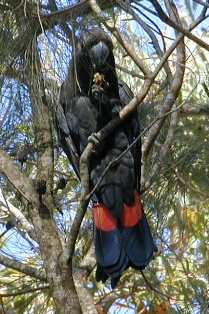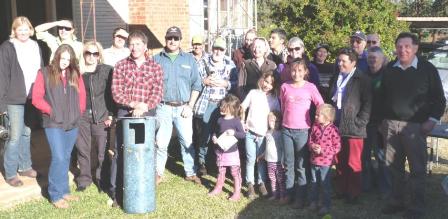Glossy Black-Cockatoo conservation in the Murrumbidgee catchment
 The Glossy Black-Cockatoo (Calyptorhynchus lathami) was once wide-spread across most of south-eastern Australia, but is now found only in patchy populations scattered across the landscape. Nationally endangered, and listed as threatened in every state in which they occur, Glossy Black-Cockatoos (aka 'Glossies') are reliant upon community conservation efforts to ensure their ongoing survival in many locations
The Glossy Black-Cockatoo (Calyptorhynchus lathami) was once wide-spread across most of south-eastern Australia, but is now found only in patchy populations scattered across the landscape. Nationally endangered, and listed as threatened in every state in which they occur, Glossy Black-Cockatoos (aka 'Glossies') are reliant upon community conservation efforts to ensure their ongoing survival in many locationsThe Glossy population found in the Riverina region of New South Wales has been identified as a population under particular threat of decline. Volunteer community groups and professional research bodies across the Murrumbidgee and Lachlan catchments have dedicated many hours to identifying local distribution and implementing conservation measures in an effort to understand and improve living conditions for these iconic birds.
Glossies feed almost exclusively on sheoak seeds, and lack of access to sufficient feeding sites has been identified in many areas as limiting local population growth. Other limiting factors include habitat fragmentation and lack of suitable tree hollows for nesting sites.
In the upper Murrumbidgee catchment, several community groups including Michelago Landcare Group, the Upper-Murrumbidgee Landcare committee, the Molonglo catchment group and Kosciuszko to Coast, to name but a few, along with Greening Australia, have propagated and planted thousands of sheoaks in the ACT and surround region. A further 10,000 drooping sheoaks are currently being raised for planting in Autumn 2013.
The lower catchment has also seen its fair share of Glossy supporters. Sheoak plantings have been carried out by Landcare groups and other volunteers in Griffith and Wagga Wagga, whilst the Murrumbidgee Field Naturalists have undertaken numerous Glossy projects with local landholders throughout the Narrandera Ranges and Brobenah Hills. Surveys have been conducted; nest boxes constructed and installed; and nesting and feeding sites identified, fenced off and monitored throughout the Ranges. In all, around 3000 hectares of high value woodland remnants with Glossy Black-Cockatoo habitat potential have been protected, mostly on private property, in very rugged country.
In 2012 a new batch of Glossy champions stepped up, straddling the border between the Murrumbidgee and Lachlan catchments. The Lachlan Fold Wildlife Action Group have been keenly pursuing knowledge of the needs of their local Glossy population and the conservation activities of other groups across south-eastern Australia. This group of rural landholders are very proud of their birds and between planning habitat restoration activities they are taking action to raise Glossy awareness within their local community. They are currently attempting to raise funds to send members to visit and learn from the very successful Glossy Black-Cockatoo Recovery Program on Kangaroo Island, and are hoping to erect several purpose-built cocky boxes in suitable nesting areas on members' properties in 2013.

Members of the Lachlan Fold Wildlife Action Group, 2012

